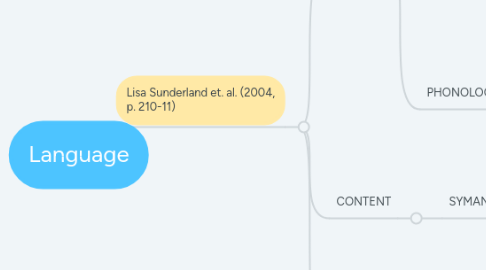
1. Lisa Sunderland et. al. (2004, p. 210-11)
1.1. FORM
1.1.1. SYNTAX
1.1.1.1. word order, sentence organization, and the relationship between words,word classes and other sentence elements
1.1.1.1.1. potential symptoms of a language learning disorder: difficulty producing, organizing or understanding complex sentences; poor rote memory; difficulty understanding the relationship of word order and meaning.
1.1.2. MORPHOLOGY
1.1.2.1. rule system for internal organization of morphemes into meaningful words
1.1.2.1.1. potential symptoms of a language learning disorder: struggle with formation of: regular/irregular noun plurals (-s, -z, -ez, -ren) and possessives (-'s, -s'); 3rd person singular of present-tense verbs (-s, -d, -ed); past tense of regular/irregular verbs (-t, -d, -ed); comparative and superlative forms of adjectives (-er, -est); cross-categorical use of inflectional endings (-s, -'s,-s'); adverb derivation (-ly); noun derivation (-er), comprehension of use of prefixes (post-, pre-, pro-, anti-).
1.1.3. PHONOLOGY
1.1.3.1. rule system for distribution and sequencing of phonemes/sounds in words within a language
1.1.3.1.1. potential symptoms of a language learning/reading disorder: associating sounds to symbols and combinations of sounds/symbols (letters) to words.
1.2. CONTENT
1.2.1. SYMANTICS
1.2.1.1. governs the meaning of words and combination of words within the content of language
1.2.1.1.1. potential symptoms of a language learning disorder: no or slow growth in vocabulary; difficulty in word-finding; use of filler words, ex. "things", "stuff". Words with multiple meanings or humor are challenges; attachment to the most concrete form/meaning of a word; very literal interpretation and usage.
1.3. USE
1.3.1. PRAGMATICS
1.3.1.1. concerned with the communicative context and social function of language use; "language comes together"
1.3.1.1.1. potential symptoms of a language learning disorder: difficulty interpreting social language clues properly, ex. humor, sarcasm; with taking turns; irrelevant info: too much, not enough inappropriate; difficulty interpreting or signaling with non-verbal cues such as facial expressions, body posture, eye gaze, etc.; could be misinterpreted as rude, disrespectful behavior instead of issue with language.
